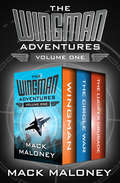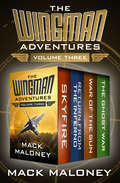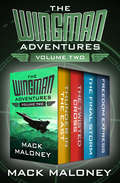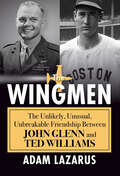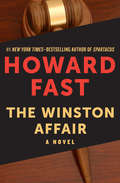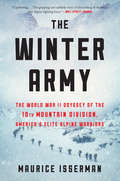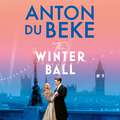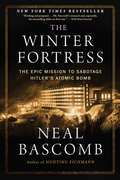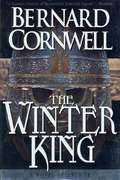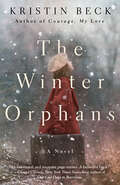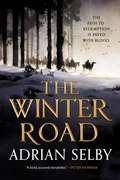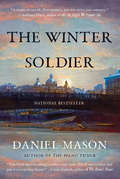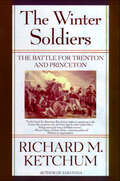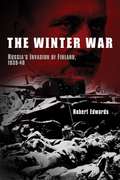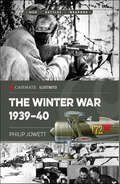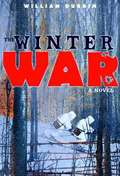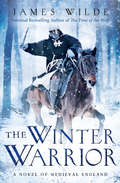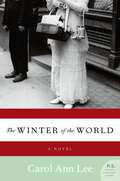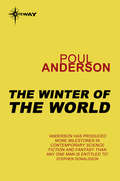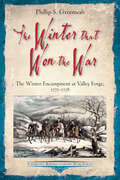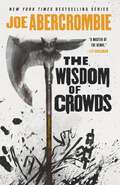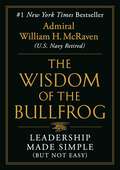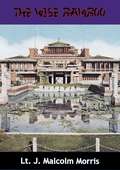- Table View
- List View
The Wingman Adventures Volume One: Wingman, The Circle War, and The Lucifer Crusade (Wingman)
by Mack MaloneyThe first three books in the bestselling military adventure series by &“the best high-action thriller writer out there today, bar none&” (Jon Land). With nearly a quarter of a million copies sold, this high-octane series features Hawk Hunter, a fearless fighter pilot who saves the not-so-distant future United States from the brink of all-out anarchy. Wingman: World War III started in Western Europe with a Soviet nerve gas attack that laid waste to France, Germany, and Spain. The world&’s democracies fought back against the Russians but could not save America from a devastating nuclear strike. Two years after Soviet nukes rained from the sky, US Air Force pilot Hawk Hunter gets a message to report to his old commander. America is in pieces: Pirates rule the skies and an airborne armada is plotting to attack Football City (formerly St. Louis). The armada is made up of criminals flying state-of-the-art jets, and Hunter will do whatever it takes to reclaim his ravaged homeland. The Circle War: One of the most decorated pilots of the old US Air Force, Hawk Hunter now flies for the Pacific American Air Corps, a group of sky jockeys who are ready to fight to save what&’s left of America after a nuclear sneak attack shattered the nation into a collection of warring states dominated by criminals, fascists, and pirates. Flying his U-2 over the frozen tundra late one night, Hunter detects a full-scale Soviet invasion force of fifty jet fighters. World War IV is about to begin. The Lucifer Crusade: After expelling a Russian invasion force, Hawk Hunter sets out in pursuit of Viktor Robotov, the sinister terrorist behind the attack. In a world where it&’s a crime to wave stars and stripes, Hunter paints his F-16 red, white, and blue, and tears up the sky in search of revenge. There are hundreds of killers on his tail, but Hunter has only one target—and he never misses.
The Wingman Adventures Volume Three: Skyfire, Return from the Inferno, War of the Sun, and The Ghost War (Wingman)
by Mack MaloneyHawk Hunter is back—in the bestselling military adventure series by &“the best high-action thriller writer out there today, bar none&” (Jon Land). With nearly a quarter of million copies sold, this high-octane series features Hawk Hunter, a fearless fighter pilot who saves the not-so-distant-future United States from the brink of all-out anarchy. Skyfire: In the chaos that followed the end of World War III, Maj. Hawk Hunter took refuge in the arms of a woman named Dominique. But Hunter&’s campaign soon tore them apart, and he was forced to send her to Canada, where his enemies claimed Dominique as their own. Drugged, tortured, and imprisoned, she waits helplessly—praying for his return. But while Hunter embarks on a daring raid to rescue his beloved, another threat is coming—in the sleek black nuclear submarines now steaming toward the eastern seaboard, whose warheads threaten everything Hunter is fighting to rebuild. Return from the Inferno: Just as America is beginning to recover from nuclear war, her enemies attack again. As ace pilot Hawk Hunter battles the horde of Nordic mercenaries who have ravaged the East Coast, another army lands in California: the combined forces of the dictatorships of East Asia. The Second Axis is here. Hunter leads the charge, flying his famous red, white, and blue F-16 into the invasion&’s maw. But this is the first time the Wingman does not come out the other side. Their champion gone, America&’s soldiers carry on, engaging in guerilla warfare to protect the country&’s interior, keeping hope alive that Hunter is out there somewhere, planning a counterattack. War of the Sun: An army of cultish mercenaries from East Asia has seized the West Coast, conquering territory as far east as the Rocky Mountains—all in the name of Hashi Pushi, a Japanese despot revered as a god. With the support of two submarines patrolling the Pacific, each armed with a nuclear warhead, the invaders have promised that any counterattack will result in the annihilation of two American cities—a price the battle-scarred populace is not prepared to pay. Onboard the carrier Enterprise, Hunter prepares to strike. His target is not the submarines, but Tokyo itself, where his fellow pilots will attack this warrior cult from the top down. The Ghost War: A pilot patrolling the South Pacific discovers Xmas Island is nothing more than a blackened hole in the ground. The carnage was wreaked by a battleship armed with an array of sixteen-inch cannons that, in a matter of minutes, could obliterate any city on earth. As far as Maj. Hawk Hunter is concerned, that constitutes a direct threat to the West Coast—a threat he must neutralize personally.
The Wingman Adventures Volume Two: Thunder in the East, The Twisted Cross, The Final Storm, and Freedom Express (Wingman)
by Mack MaloneyHawk Hunter is America&’s best hope—in the bestselling military adventure series by &“the best high-action thriller writer out there today, bar none&” (Jon Land). With nearly a quarter million copies sold, this high-octane series features Hawk Hunter, a fearless fighter pilot who saves the not-so-distant-future United States from the brink of all-out anarchy. Thunder in the East: The Soviet sneak attack crippled America, breaking the US into warring factions ruled by dictators, thugs, and thieves. In the western territories, democracy has survived—thanks to Maj. Hawk Hunter, the greatest fighter pilot of his time, and the Pacific American Air Corps. After narrowly stopping a Soviet ground invasion, Hunter vows to restore his beloved country—and he will begin by reclaiming Football City, formerly known as St. Louis, until it was captured by a criminal army from New Chicago. Only Hunter can break through its walls and lead his army onward to reclaim Washington, DC. The Twisted Cross: A new threat has emerged from the south. An army of neo-Nazis has seized control of the Panama Canal, and they&’re armed to the teeth. Their hateful ideology may be decades out of date, but these jackbooted killers have firepower that is state-of-the-art. They&’re going to need it . . . because the Wingman is coming. The Final Storm: The Soviet Union had nearly been defeated when the vice president of the United States revealed himself as a traitor. He deactivated the defense grid just long enough for the Russians to strike, reducing America to a battle-scarred wasteland. Fighter pilot Hawk Hunter rebuilt the country one dogfight at a time. Now he&’s headed for the vice president&’s compound in Bermuda, backed by a team of commandos, to bring America&’s greatest traitor to justice, dead or alive. Freedom Express: After fighting off the Red Army invasion, Maj. Hawk Hunter and what remained of the country&’s armed forces spent years rebuilding their nation. Only one territory was left deserted: the Southwest, now known as the Badlands. To reestablish the overland route between the eastern and western regions, a train of modern pioneers is sent across the desert. The train makes it safely, but when it arrives in Los Angeles, every passenger on board has vanished. To bring the fight to the bandits, Hunter trades in his F-16 for his own specially designed locomotive: a super-fortress on rails. The new Wild West is about to be tamed—Wingman-style.
The Wingmen: The Unlikely, Unusual, Unbreakable Friendship Between John Glenn and Ted Williams
by Adam LazarusCASEY Award Finalist for Best Baseball Book of the YearThe untold story of the unique fifty-year friendship between two American icons: John Glenn, the unassailable pioneer of space exploration and Ted Williams, indisputably the greatest hitter in baseball history. It was 1953, the Korean War in full throttle, when two men—already experts in their fields—crossed the fabled 38th Parallel into Communist airspace aboard matching Panther jets. John Glenn was an ambitious operations officer with fifty-nine World War II combat missions under his belt. His wingman was Ted Williams, the two-time American League Triple Crown winner who, at the pinnacle of his career, was inexplicably recalled to active service in the United States Marine Corps. Together, the affable flier and the notoriously tempestuous left fielder soared into North Korea, creating a death-defying bond. Although, over the next half century, their contrasting lives were challenged by exhilarating highs and devastating lows, that bond would endure. Through unpublished letters, unit diaries, declassified military records, manuscripts, and new and illuminating interviews, The Wingmen reveals an epic and intimate portrait of two heroes—larger-than-life and yet ineffably human, ordinary men who accomplished the extraordinary. At its heart, this was a conflicted friendship that found commonality in mutual respect—throughout the perils of war, sports dominance, scientific innovation, cutthroat national politics, the burden of celebrity, and the meaning of bravery. Now, author Adam Lazaraus sheds light on a largely forgotten chapter in these legends&’ lives—as singular individuals, inspiring patriots, and eventually, however improbable, profoundly close friends.
The Winston Affair: A Novel
by Howard FastDuring the Second World War, a military lawyer is embroiled in the toughest case of his career when he must defend a fellow murderous officerIn the midst of World War II, Captain Barney Adams&’s superiors call on him with a very unusual request. A troubled US army lieutenant has confessed to murdering a British officer, and Captain Adams has been assigned as his defense attorney. Military court officials want the cleanest possible trial for the lieutenant, and they believe that Captain Adams, a war hero and distinguished lawyer, is the best man for the job. But when Adams begins to investigate the murder, he finds that this seemingly open-and-shut case is actually much more complicated. Before long he is absorbed in a dramatic struggle for a fair trial against the most overwhelming odds. Thrilling and thought-provoking, The Winston Affair is a powerful portrait of a man torn between the wishes of his superiors and the call for justice. This ebook features an illustrated biography of Howard Fast including rare photos from the author&’s estate.
The Winter Army: The World War II Odyssey of the 10th Mountain Division, America's Elite Alpine Warriors
by Maurice Isserman&“Compelling and readable . . . I had serious trouble putting this book down.&”—John C. McManus, author of Fire and Fortitude and The Dead and Those About to Die The epic story of the U.S. Army&’s 10th Mountain Division, whose elite soldiers broke the last line of German defenses in Italy&’s mountains in 1945, spearheading the Allied advance to the Alps and final victory. At the start of World War II, the US Army had two cavalry divisions—and no mountain troops. The German Wehrmacht, in contrast, had many well-trained and battle-hardened mountain divisions, some of whom by 1943 blocked the Allied advance in the Italian campaign. Starting from scratch, the US Army developed a unique military fighting force, the 10th Mountain Division, drawn from the ranks of civilian skiers, mountaineers, and others with outdoor experience. The resulting mix of Ivy League students, park rangers, Olympic skiers, and European refugees formed the first specialized alpine fighting force in US history. By the time it deployed to Italy at the beginning of 1945, this ragtag group had coalesced into a tight-knit unit. In the months that followed, at a terrible cost, they spearheaded the Allied drive in Italy to final victory. Ranging from the ski slopes of Colorado to the towering cliffs of the Italian Alps, The Winter Army is a saga of an unlikely band of soldiers forged in the heat of combat into a brotherhood whose legacy lives on in US mountain fighters to this day.
The Winter Ball: A sweeping story of love and war from the bestselling author of the Buckingham hotel series
by Anton Du BekeDon't miss the dazzling new novel from the nation's favourite entertainer - available to pre-order now!'Heartbreaking, heartlifting and enchanting' CAROL KIRKWOOD1942, LondonIn the darkest times, hope lights the way...As the snow falls on Berkeley Square, the staff at the Buckingham Hotel are busy preparing for the arrival of American soldiers. 'King of the Ballroom' Raymond de Guise is rallying the performers for the forthcoming Winter Ball, with a familiar face returning to surprise the guests. As rumours circulate that the Royal Party will be in attendance on the night, tensions begin to rise on and off the dancefloor as shocking secrets are revealed. Raymond has always been a keeper of secrets, most especially his own. Unbeknownst to his friends and family, he has returned from the frontline to the ballroom to feed information from high society to the British government...As the festive season approaches, he is given his most dangerous assignment yet, welcoming three American officials into his home with the knowledge that one is a traitor. As the Christmas baubles glitter, he must discover who has treachery in his heart before it is too late.Will Raymond be able to protect his home and his country? Or will this be the time he finally loses what he loves the most?The Winter Ball is a sweeping wartime saga, filled with drama, intrigue, dance and romance from the star of Strictly Come Dancing, Anton Du Beke.
The Winter Fortress: The Epic Mission to Sabotage Hitler's Atomic Bomb
by Neal BascombFrom the internationally acclaimed, best-selling author of Hunting Eichmann and The Perfect Mile, an epic adventure and spy story about the greatest act of sabotage in all of World War II. It's 1942 and the Nazis are racing to be the first to build a weapon unlike any known before. They have the physicists, they have the uranium, and now all their plans depend on amassing a single ingredient: heavy water, which is produced in Norway's Vemork, the lone plant in all the world that makes this rare substance. Under threat of death, Vemork's engineers push production into overdrive. For the Allies, the plant must be destroyed. But how would they reach the castle fortress set on a precipitous gorge in one of the coldest, most inhospitable places on Earth? Based on a trove of top secret documents and never-before-seen diaries and letters of the saboteurs, The Winter Fortress is an arresting chronicle of a brilliant scientist, a band of spies on skies, perilous survival in the wild, sacrifice for one's country, Gestapo manhunts, soul-crushing setbacks, and a last-minute operation that would end any chance Hitler could obtain the atomic bomb--and alter the course of the war.
The Winter King: A Novel of Arthur (The Warlord Chronicles, No. #1)
by Bernard Cornwell[Back Cover] The tale begins in Dark Age Britain, a land where Arthur has been banished and Merlin has disappeared, where a child-king sits unprotected on the throne, where religion vies with magic for the souls of the people. It is to this desperate land that Arthur returns, a man at once utterly human and truly heroic: a man of honor, loyalty, and amazing valor; a man who loves Guinevere more passionately than he should; a man whose life is at once tragic and triumphant. As Arthur fights to keep a flicker of civilization alive in a barbaric world, Bernard Cornwell makes a familiar tale into a legend all over again.
The Winter Orphans
by Kristin BeckA poignant and ultimately triumphant novel based on the incredible true story of children who braved the formidable danger of guarded, wintry mountain passes in France to escape the Nazis, from the acclaimed author of Courage, My Love. Southern France, 1942 In a remote corner of France, Jewish refugee Ella Rosenthal has finally found a safe haven. It has been three years since she and her little sister, Hanni, left their parents to flee Nazi Germany, and they have been pursued and adrift in the chaos of war ever since. Now, they shelter among one hundred other young refugees in a derelict castle overseen by the Swiss Red Cross. Swiss volunteers Rösli Näf and Anne-Marie Piguet uphold a common mission: to protect children in peril. Rösli, a stubborn and resourceful nurse, directs the colony of Château de la Hille, and has created a thriving community against all odds. Anne-Marie, raised by Swiss foresters, becomes both caretaker and friend to the children, and she vows to do whatever is necessary to keep them safe. However, when Germany invades southern France, safeguarding Jewish refugees becomes impossible. Château de la Hille faces unrelenting danger, and Rösli and Anne-Marie realize that the only way to protect the eldest of their charges is to smuggle them out of France. Relying on Rösli's fierce will and Anne-Marie's knowledge of secret mountain paths, they plot escape routes through vast Nazi-occupied territory to the distant border. Amid staggering risk, Ella and Hanni embark on a journey that, if successful, could change the course of their lives and grant them a future.
The Winter Road
by Adrian SelbyThe brutally powerful story of a daring warrior traveling a path that might bring salvation to her people...or lead her to ruin. For fans of Mark Lawrence, Andrzej Sapkowski, and Joe Abercrombie.The Circle - a thousand miles of perilous forests and warring clans. No one has ever tamed such treacherous territory before, but ex-soldier Teyr Amondsen, veteran of a hundred battles, is determined to try.With a merchant caravan protected by a crew of skilled mercenaries, Teyr embarks on a dangerous mission to forge a road across the untamed wilderness that was once her home. But a warlord has risen in the wilds of the Circle, uniting its clans and terrorizing its people. Teyr's battles are far from over . . .For more from Adrian Selby, check out:Snakewood
The Winter Rose: The heartwarming festive novel from the Sunday Times bestselling author
by Katie FlynnThe heatwarming festive follow-up to The Rose Queen, from beloved Sunday Times bestselling author Katie Flynn._____________________________________________Liverpool, 1941: After German bombs shatter the life Cadi has built for herself in Liverpool, she's more determined than ever to sign up and do her bit. Joining the WAAF also means she is closer to her beau - until Jez is sent thousands of miles from home. . . While Jez is in Africa, someone from the past starts spreading vicious rumours that could threaten their relationship, and Cadi finds herself torn between keeping secrets and telling the truth to protect those she holds dear.Cadi has always believed that their love can weather any storm but as the snow sweeps in, she faces an impossible choice. Will her decision leave her broken-hearted or will Cadi and Jez be reunited in time for Christmas?'A story of heartbreak and love, this book will keep you enthralled from start to finish' Northern Echo_________________________________________WHY READERS LOVE KATIE FLYNN:'Her characters are like old friends!!''Takes you on a journey of heartbreak and joy''Heartwarming romance''Hard to put down!!'
The Winter Soldier
by Daniel Mason"A dream of a novel... Part mystery, part war story, part romance." --Anthony Doerr, author of All the Light We Cannot SeeVienna, 1914. Lucius is a twenty-two-year-old medical student when World War I explodes across Europe. Enraptured by romantic tales of battlefield surgery, he enlists, expecting a position at a well-organized field hospital. But when he arrives, at a commandeered church tucked away high in a remote valley of the Carpathian Mountains, he finds a freezing outpost ravaged by typhus. The other doctors have fled, and only a single, mysterious nurse named Sister Margarete remains.But Lucius has never lifted a surgeon's scalpel. And as the war rages across the winter landscape, he finds himself falling in love with the woman from whom he must learn a brutal, makeshift medicine. Then one day, an unconscious soldier is brought in from the snow, his uniform stuffed with strange drawings. He seems beyond rescue, until Lucius makes a fateful decision that will change the lives of doctor, patient, and nurse forever.From the gilded ballrooms of Imperial Vienna to the frozen forests of the Eastern Front; from hardscrabble operating rooms to battlefields thundering with Cossack cavalry, The Winter Soldier is the story of war and medicine, of family, of finding love in the sweeping tides of history, and finally, of the mistakes we make, and the precious opportunities to atone.
The Winter Soldiers: The Battle for Trenton and Princeton
by Richard M. KetchumThe author of Decisive Day chronicles two pivotal battles in the Revolutionary War and the adversity faced by American troops.The Winter Soldiers is the story of a small band of men held together by George Washington in the face of disaster and hopelessness, desperately needing at least one victory to salvage both cause and country.In the fall of 1776 the British delivered a crushing blow to the Revolutionary War efforts. New York fell and the anguished retreat through New Jersey followed. Winter came with a vengeance, bringing what Thomas Paine called “the times that try men’s souls.”Richard M. Ketchum tells the tale of unimaginable hardship and suffering that culminated in the battles of Trenton and Princeton. Without these triumphs, the American Revolution that had begun so bravely could not have gone on.Praise for The Winter Soldiers“Superb military history of an intimacy and narrative power such as is rarely written.” —Orville Prescott“In this book the American Revolution begins to appear as a tale of men like ourselves who did their best in what looked like a failing cause and won a brilliant success.” —Bruce Catton, Pulitzer Prize–winning author of Stillness at Appomattox
The Winter War
by Robert Edwards"Edwards recounts events, both shameful and heroic, with insight, conviction and considerable wit." —Publishers WeeklyOn November 30, 1939, the Soviet Union's Red Army invaded the young nation-state of Finland, in the full expectation of routing the small, ill-equipped Finnish army and annexing the former Russian territory by the end of the year. But Finland held out for 105 bitterly cold, fiercely combative days, until March 15, 1940, when a peace agreement ended the short, savage Winter War. At the stirring center of the story lie the resourcefulness and resolve of the Finnish people, who against all military odds—in want of ammunition, food, sleep, and troops—fought a blundering, ineptly commanded Red Army to a standstill. On March 15, they ceded to the Soviet 11 percent of their territory and 30 percent of their economic assets, but none of their national pride. The Russians meanwhile had markedly damaged their international standing and effectively ruined their military reputation-to such an extent, as this probing chapter in World War II history demonstrates, that Germany, with proud-blooded Finland as an ally, dared to launch its 1940 invasion of Russia. At the same time, though, the fiasco of the Winter War forced Stalin to acknowledge the shortcomings of the Red Army and to reform it: Germany would fall at Stalingrad in 1941. With authority, this skillfully narrated military history unfolds its story of the four-month Soviet-Finnish war and explores its consequences from London to Moscow, from Helsinki to Paris, to Washington, DC.
The Winter War 1939–40 (Casemate Illustrated)
by Philip Jowett"Jowett has amassed an impressive amount of detail, yet the writing never bogs down. He leads the reader through this war with precision and employs images to great effect." — New York Journal of Books When the Soviet Union invaded Finland in late 1939, what transpired was a true “David and Goliath” conflict. When Finland refused a number of Soviet demands, including the ceding of substantial border territories ostensibly to enable the Soviets to protect Leningrad, the Soviets responded by launching an invasion. The invasion involved a large Soviet army, with several thousand tanks, and a large air force. But to the world's surprise the Finnish Army—many of them reservists without proper uniforms and limited ammunition—and Air Force battled overwhelming odds, and managed to resist Russian attacks for over two months, inflicting serious losses. Geography played its part as much of the Finnish-Soviet border was impassable, meaning that Soviet numerical superiority was of less import. Operating in the winter, with temperatures ranging as low as -43F, the Finns’ determined resistance won them international reputation. Although hostilities finally ended in a peace treaty that saw Finland cede 9% of its territory, Soviet losses had been heavy, and Finland retained its sovereignty. This fully illustrated text will cover the forces involved and all stages of the Winter War.
The Winter War: A Novel
by William DurbinWhen the Soviet Union invades its tiny neighbor Finland in November 1939, Marko volunteers to help the war effort. Even though his leg was weakened by polio, he can ski well, and he becomes a messenger on the front line, skiing in white camouflage through the forests at night. The dark forest is terrifying, and so are the odds against the Finns: the Russians have 4 times as many soldiers and 30 times as many planes. They have 3000 tanks, while the Finns have 30. But a tank is no help in the snowy forest-a boy on skis is. And the Russians don't know winter the way the Finns do, or what tough guerrilla warriors the Finns are. Marko teams up with another messenger, Karl. Gradually Marko learns that Karl's whole family was killed by the Russians. And Karl has a secret-he's really Kaari, a girl who joined up to get revenge for her family's deaths.From the Hardcover edition.
The Winter Warrior: A Novel Of Medieval England
by James Wilde1067. Following the devastating destruction of the Battle of Hastings, William the Bastard and his men have descended on England. Villages are torched; men, women, and children are put to the sword as the Norman king attempts to impose his cruel will upon this unruly nation. But there is one who stands in the way of the invader's savagery. He is called Hereward. He is a warrior and master tactician and as adept at battle as the imposter who sits upon the throne. And he is England's last hope. In a Fenlands fortress of water and wild wood, Hereward's resistance is simmering. His army of outcasts grows by the day—a devil's army that emerges out of the mists and the night, leaving death in its wake. But William is not easily cowed. Under the command of his ruthless deputy, Ivo Taillebois—the man they call 'the Butcher'—the Norman forces will do whatever it takes to crush the rebels, even if it means razing England to the ground. Here then is the tale of the bloodiest rebellion England has ever known—the beginning of an epic struggle that will change England forever.
The Winter Warrior: A Novel of Medieval England (Hereward Ser. #2)
by James Wilde1067. Following the devastating loss of the Battle of Hastings, William the Bastard and his men have descended on England. Villages are torched and men, women, and children are put to the sword as the Norman king attempts to impose his cruel will upon this unruly nation. But there is one who stands in the way of the invader's savagery. He is called Hereward. He is a warrior and master tactician and as adept at slaughter as the imposter who sits upon the throne. And he is England's last hope. In a Fenlands fortress of water and wild wood, Hereward's resistance is simmering. His army of outcasts grows by the day--a devil's army that emerges out of the mists and the night, leaving death in its wake. But William is not easily cowed. Under the command of his ruthless deputy, Ivo Taillebois--the man they call "the Butcher"--the Norman forces will do whatever it takes to crush the rebels, even if it means razing England to the ground. Here then is the tale of the bloodiest rebellion England has ever known--the beginning of an epic struggle that will echo down the years . . .
The Winter of the World: A Novel
by Carol Ann LeeA heartbreaking and powerful story of personal demons and the hard journey back from an abyss of betrayal in the aftermath of World War IJournalist Alex Dyer made his name covering the bloody horrors of the European trenches. Yet even after the Great War is over, he cannot shake the guilt he feels for not serving on the front lines like his dearest childhood friend, Ted Eden. Worse still, Alex cannot put to rest the emotions that gnaw at him from the inside: his feelings for Clare, Ted's wife—a woman they both have loved more than life itself.A masterful debut novel from the acclaimed author of The Hidden Life of Otto Frank, Carol Ann Lee's Winter of the World combines fascinating historical detail and color with breathtaking invention. Recalling the fire of the battlefield and the nightmare of the trenches, it brilliantly evokes a volatile time when life was frozen in the present tense and looking forward was the only thing more painful than looking back.
The Winter of the World: The Winter Of The World And Twilight World
by Poul AndersonThe second Ice Age came - and civilisation was buried beneath the glaciers. Then all men became barbarians. But out of the frozen chaos three cultures emerged. The Seafolk and the Rogaviki were simple, primitive people. Ranged against them was the mighty Rahidian-Barommian Empire, a nation hungry for power, eager to exploit its superior technical knowledge. If the Empire fulfilled its ambitions, its neighbours knew they would not survive. On the day of the intended conquest they must be ready to engage the powers of science in a bloody, apocalyptic struggle for the destiny of the planet.
The Winter that Won the War: The Winter Encampment at Valley Forge, 1777–1778 (Emerging Revolutionary War Series)
by Phillip S. Greenwalt“An Army of skeletons appeared before our eyes naked, starved, sick and discouraged.” Gouverneur Morris recorded these words in his report to the Continental Congress after a visit to the Continental Army encampment at Valley Forge. Sent as part of a fact-finding mission, Morris and his fellow congressmen arrived to conditions far worse than they had initially expected. After a campaigning season that saw the defeat at Brandywine, the loss of Philadelphia, the capital of the rebellious British North American colonies, and the reversal at Germantown, George Washington and his harried army marched into Valley Forge on December 19, 1777. What transpired in the next six months prior to the departure from the winter cantonment on June 19, 1778 was truly remarkable. The stoic Virginian, George Washington solidified his hold on the army and endured political intrigue, the quartermaster department was revived with new leadership from a former Rhode Island Quaker, and a German baron trained the army in the rudiments of being a soldier and military maneuvers. Valley Forge conjures up images of cold, desperation, and starvation. Yet Valley Forge also became the winter of transformation and improvement that set the Continental Army on the path to military victory and the fledgling nation on the path to independence. In The Winter that Won the War: The Winter Encampment at Valley Forge, 1777-1778, historian Phillip S. Greenwalt takes the reader on campaign in the year 1777 and through the winter encampment, detailing the various changes that took place within Valley Forge that ultimately led to the success of the American cause. Walk with the author through 1777 and into 1778 and see how these months truly were the winter that won the war.
The Wisdom of Crowds (The Age of Madness #3)
by Joe AbercrombieFrom the New York Times bestselling author of A Little Hatred comes the stunning conclusion to the Age of Madness trilogy where the world finds itself in an unstoppable revolution, and the heroes have nothing left to lose as darkness and destruction overtake everything . . . <P><P>Chaos. Fury. Destruction.The Great Change is upon us . . .Some say that to change the world you must first burn it down. Now that belief will be tested in the crucible of revolution: the Breakers and Burners have seized the levers of power, the smoke of riots has replaced the smog of industry, and all must submit to the wisdom of crowds. <P><P>With nothing left to lose, Citizen Brock is determined to become a new hero for the new age, while Citizeness Savine must turn her talents from profit to survival before she can claw her way to redemption. Orso will find that when the world is turned upside down, no one is lower than a monarch. And in the bloody North, Rikke and her fragile Protectorate are running out of allies . . . while Black Calder gathers his forces and plots his vengeance. <P><P>The banks have fallen, the sun of the Union has been torn down, and in the darkness behind the scenes, the threads of the Weaver's ruthless plan are slowly being drawn together . . ."No one writes with the seismic scope or primal intensity of Joe Abercrombie." —Pierce Brown <P><P><b>A New York Times Best Seller</b>
The Wisdom of the Bullfrog: Leadership Made Simple (But Not Easy)
by Admiral William H. McRavenTHE INSTANT #1 New York Times BESTSELLER From the acclaimed, bestselling author of Make Your Bed—a short, inspirational book of advice and leadership lessons that Admiral McRaven collected over his four decades as a Navy SEAL. The title &“Bullfrog&” is given to the Navy SEAL who has served the longest on active duty. Admiral McRaven was honored to receive this honor in 2011 when he took charge of the United States Special Operations Command. When McRaven retired in 2014, he had 37 years as a Navy SEAL under his belt, leading men and women at every level of the special operations community. In the ensuing four years, he served as Chancellor to the entire University of Texas System, with its 230,000 students and 100,000 faculty and health care workers. During those four decades, Admiral McRaven dealt with every conceivable leadership challenge, from commanding combat operations—including the capture of Saddam Hussein, the rescue of Captain Phillips, and the raid for Osama bin Laden. THE WISDOM OF THE BULLFROG draws on these and countless other experiences from Admiral McRaven&’s incredible life, including crisis situations, management debates, organizational transitions, and ethical dilemmas, to provide readers with the most important leadership lessons he has learned over the course of his forty years of service. Each chapter provides a Make Your Bed-like parable, rich with insights like those featured in his bestselling memoir, Sea Stories, about the specific leadership traits required to be at the top of your game, including: Who Dares, Wins Run to the Sound of the Guns No Plan Survives First Contact with the Enemy THE WISDOM OF THE BULLFROG is Admiral McRaven&’s clear-eyed treatise on the leadership qualities that separate the good from the truly great.
The Wise Bamboo
by Lt. J. Malcolm MorrisWhen Lieutenant Morris arrived in Japan in 1945 he was not seeking the position of manager of the Imperial Hotel in Tokyo. He came simply to run it as a billet for senior officers of the Allied Occupation Forces. But hotels, it seemed, were already in his blood, and when he was demobilized in 1946 he decided "to stay around just to see what could possibly happen next."The Wise Bamboo is his account of what did happen.
